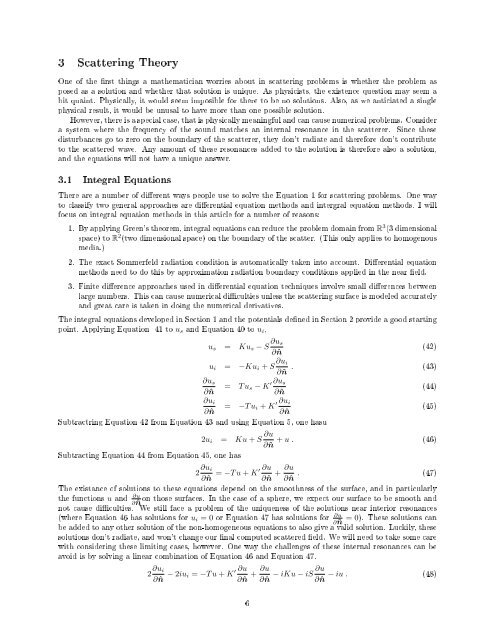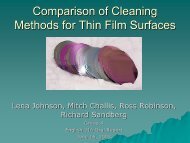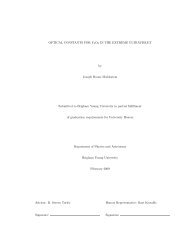Acoustic Scattering from a Sphere - Steve Turley
Acoustic Scattering from a Sphere - Steve Turley
Acoustic Scattering from a Sphere - Steve Turley
You also want an ePaper? Increase the reach of your titles
YUMPU automatically turns print PDFs into web optimized ePapers that Google loves.
3 <strong>Scattering</strong> TheoryOne of the rst things a mathematician worries about in scattering problems is whether the problem asposed as a solution and whether that solution is unique. As physicists, the existence question may seem abit quaint. Physically, it would seem imposible for there to be no solutions. Also, as we anticiated a singlephysical result, it would be unusal to have more than one possible solution.However, there is a special case, that is physically meaningful and can cause numerical problems. Considera system where the frequency of the sound matches an internal resonance in the scatterer. Since thesedisturbances go to zero on the boundary of the scatterer, they don't radiate and therefore don't contributeto the scattered wave. Any amount of these resonances added to the solution is therefore also a solution,and the equations will not have a unique answer.3.1 Integral EquationsThere are a number of dierent ways people use to solve the Equation 1 for scattering problems. One wayto classify two general approaches are dierential equation methods and intergral equation methods. I willfocus on integral equation methods in this article for a number of reasons:1. By applying Green's theorem, integral equations can reduce the problem domain <strong>from</strong> R 3 (3 dimensionalspace) to R 2 (two dimensional space) on the boundary of the scatter. (This only applies to homogenousmedia.)2. The exact Sommerfeld radiation condition is automatically taken into account. Dierential equationmethods need to do this by approximation radiation boundary conditions applied in the near eld.3. Finite dierence approaches used in dierential equation techniques involve small dierences betweenlarge numbers. This can cause numerical diculties unless the scattering surface is modeled accuratelyand great care is taken in doing the numerical derivatives.The integral equations developed in Section 1 and the potentials dened in Section 2 provide a good startingpoint. Applying Equation 41 to u s and Equation 40 to u i ,u s = Ku s − S ∂u s∂ˆnu i = −Ku i + S ∂u i∂ˆn . (43)∂u s∂ˆn = T u s − K ′ ∂u s∂ˆn(44)∂u i∂ˆn = −T u i + K ′ ∂u i∂ˆn(45)Subtractring Equation 42 <strong>from</strong> Equation 43 and using Equation 5, one hasu2u i = Ku + S ∂u∂ˆn + u . (46)Subtracting Equation 44 <strong>from</strong> Equation 45, one has2 ∂u i∂u= −T u + K′∂ˆn ∂ˆn + ∂u∂ˆn . (47)The existance of solutions to these equations depend on the smoothness of the surface, and in particularlythe functions u and∂ˆn ∂u on those surfaces. In the case of a sphere, we expect our surface to be smooth andnot cause diculties. We still face a problem of the uniqueness of the solutions near interior resonances(where Equation 46 has solutions for u i = 0 or Equation 47 has solutions for∂ˆn ∂u = 0). These solutions canbe added to any other solution of the non-homogeneous equations to also give a valid solution. Luckily, thesesolutions don't radiate, and won't change our nal computed scattered eld. We will need to take some carewith considering these limiting cases, however. One way the challenges of these internal resonances can beavoid is by solving a linear combination of Equation 46 and Equation 47.2 ∂u i∂ˆn − 2iu i = −T u + K ′ ∂u∂ˆn + ∂u∂u− iKu − iS − iu . (48)∂ˆn ∂ˆn(42)6





